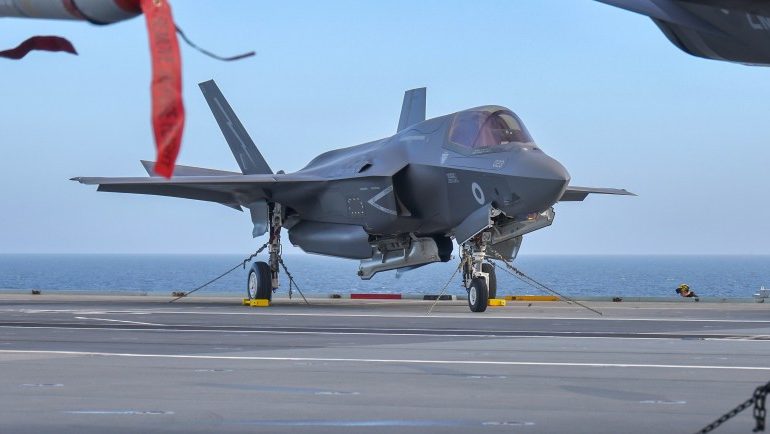THIS is the jaw dropping moment a pair of RAF Dambusters in massive F-35B fighter jets elegantly land on Britain’s biggest warship.
The two Lightning jets joined up with over 90,000 Nato personnel to take part in practise drills in the largest European training exercise since the Cold War.
One of the F-35B Lightning jets after landing on the HMS Prince of WalesPA
MoDThe moment the two jets come in to land[/caption]
PAAround 20,000 British armed forces are joining in with the Nato drills[/caption]
PAOne of the powerful jets landing on the aircraft carrier[/caption]
Impressive footage shows the two mammoth F-35B’s soaring over the top of the HMS Prince of Wales before coming in to land on the Royal Navy aircraft carrier.
Dubbed Exercise Steadfast Defender, the five-month Nato exercise is designed to prepare 32 countries for a war with Russia as brave troops get ready for any land, sea, air, cyber or space operations.
Commanders said the drill was designed to simulate the period of “rising tensions before the outbreak of war”.
Almost 600 British armoured vehicles and light artillery guns were packed on to ferries at Marchwood military docks near Southampton on February 13.
In total, around 20,000 British armed forces will take part in the Steadfast Defender drills, which include RAF jets and Royal Navy warships and submarines.
The Royal Navy has also sent two aircraft carriers – the HMS Prince of Wales and the even larger HMS Queen Elizabeth and eight warships to stage and test conflict scenarios in drills named “Joint Warrior”.
They are expected to continue through to May.
The blockbuster Nato operation will see alliance members rehearsing how US troops could reinforce European allies on the alliance’s eastern flank if a conflict were to flare up.
US paratroopers will later swoop in across eastern Europe as part of the “Swift Response” drill, while thousands of troops will stage battles across on Poland and into the Baltics for “Dragon-24”.
More than 50 ships from aircraft carriers to destroyers will take part, as well as more than 80 fighter jets, helicopters and drones and at least 1,100 combat vehicles including 133 tanks and 533 infantry fighting vehicles.
The plan behind Steadfast Defender 2024 (STDE24) is to “promote readiness across the strategic, operational and tactical level,” Brigadier General Gunnar Bruegner said.
He added: “The sheer size and ambition of this exercise will show us where we are and how we need to adapt.”
One that will send a “clear message inside and outside the military (alliance) that we are ready!”
It’s an opportunity to carry out “stress-testing from the top to the bottom,” Bruegner said.
“This is how we prepare ourselves, stress this with troops on ground and build capacity towards deterrence.”
THE SNOW WAR
Speaking to The Sun last month, Armed Forces Minister James Heappey explained that if Nato went to war with Russia, Britain’s main role would be fighting in Arctic conditions – some of the toughest in the world.
Because of this Brit troops on the Royal Marines’ Cold Weather Aviation Operators Course have been training to survive and operate in freezing environments.
Temperatures in Norway can regularly plunge well below -20C.
The troops have been through brutal week-long training packages to prepare themselves.
This includes lessons in classrooms followed by five nights of training in the field where they learn to spot drones, build forts and use some of the most recent gadgets the military has at its disposal.
This comes after a damning new report detailed how the UK’s military is not prepared for a full-blown war with Russia.
The “overstretched” British armed forces would only last a “couple of months” and are “far below the level required to counter with certainty a threat from the Russian Army,” MPs warned.
History of the Dambusters
In 1943, a new squadron was formed to carry out raids on dams in Germany that would go on to be known as the Dambusters.
Initially codenamed Squadron X and then 617 Squadron, the group of troops from Britain, Canada, Australia, New Zealand and the USA were bravely led by 24-year old Wing Commander Guy Gibson.
In the night of May, 16, 1943, Gibson led his men on an audacious bombing raid to destroy three dams in the Ruhr valley, the industrial heartland of Germany.
The mission was called Operation ‘Chastise’ and was seen as a revolutionary event for the bomb used in the strikes.
The dams were fiercely protected as torpedo nets in the water stopped any form of underwater attacks and anti-aircraft guns defended them against enemy bombers from above.
So the squad needed to come up with a secret weapon to win the battles – the ‘bouncing bomb’.
During the raids 133 aircrew in 19 Lancasters took off in three waves to obliterate the dams but they suffered big losses.
Fifty three men were killed and three ended as prisoners of war from the 617 Squadron as an additional 1,300 were killed in the resulting flooding.
The surviving crew came home as heroes and leader Gibson was awarded the Victoria Cross for his part in the raid.
The 617 Squadron then went on to be used as a specialist precision bombing unit, experimenting with new bomb sights, target marking techniques and colossal new ‘earthquake’ bombs.
Since then, the squadron has been pivotal in British-backed battles and have gone on to dominate the airs with F-35B Lightning jets.
AlamyThe Dambusters 617 Squadron RAF during an attack[/caption]
PAThe massive jets are set to help out in the practise drills that will continue through to May[/caption]
Leave a comment








